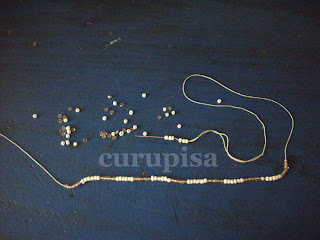Conchitas/ Little shells*
 Aprenderemos esta sucesión de pequeñas conchitas perladas, que se puede utilizar como borde, puntilla, pulsera, adorno para una bombachita... lo que se le ocurra.
Aprenderemos esta sucesión de pequeñas conchitas perladas, que se puede utilizar como borde, puntilla, pulsera, adorno para una bombachita... lo que se le ocurra.We'll learn this cute series of pearly little shells, that you can use as an edging, as a lace, as an embelishment for your panties... anything you can come up with.
 Cargamos mostacillas (chaquiras, abalorios, cuentas) en el hilo que usaremos para tejer. Para cada conchita necesitaremos 6 cuentas de un color y 6 de otro (salvo que usted sea más viva que la maestra y decida evitarse un surmenage** utilizando un único color). Teniendo presente esto, insertaremos la cantidad necesaria para lograr el largo deseado. Como mi tejido alcanzará las 8 conchitas, preparo 16 grupos de cuentas, 8 blancas y 8 transparentes.
Cargamos mostacillas (chaquiras, abalorios, cuentas) en el hilo que usaremos para tejer. Para cada conchita necesitaremos 6 cuentas de un color y 6 de otro (salvo que usted sea más viva que la maestra y decida evitarse un surmenage** utilizando un único color). Teniendo presente esto, insertaremos la cantidad necesaria para lograr el largo deseado. Como mi tejido alcanzará las 8 conchitas, preparo 16 grupos de cuentas, 8 blancas y 8 transparentes.We put sead beads on the thread we intend to use for the work. For each shell, we need 6 beads in one color and 6 in another (unless you're smarter than this teacher and decide to avoid surmenage ** and use one single colour). Since my work will finish in 8 shells, I put 16 groups of beads, 8 in white, 8 transparent.
 Repetimos los dos pasos anteriores hasta obtener el largo deseado.
Repetimos los dos pasos anteriores hasta obtener el largo deseado.¿Cómo sabremos cuándo está? Cada grupo de 3 cad y 1 pa forma un arquito. Para formar una conchita, necesitamos 2 arquitos, más uno para girar . Para 8 conchitas, serán 16 arquitos, pero debemos agregar 1 arquito más.
We repeat the previous 2 steps 'til we get the desired length.
When is that? Each group of 3 ch st and 1 dc forms an eyelet. To form a little shell, we need 2 eyelets, plus one to turn the work. For 8 little shells, it'll be 16 eyelets, plus one.
 En el primer arco, 1 pb; en el arco siguiente, 6 pa con mostacillas. Esto se hace así:
En el primer arco, 1 pb; en el arco siguiente, 6 pa con mostacillas. Esto se hace así:In the first eyelet, 1sc; in the next eyelet, 6 beaded dc. A beaded dc is done as follows:
 Comenzamos el pa como usualmente: tomamos lazada, insertamos el ganchillo en la base, lazada, extraemos la lazada del punto de base, tomamos una lazada, cerramos los dos puntos sobre el ganchillo.
Comenzamos el pa como usualmente: tomamos lazada, insertamos el ganchillo en la base, lazada, extraemos la lazada del punto de base, tomamos una lazada, cerramos los dos puntos sobre el ganchillo.Start the dc as usual: yarn over, insert hook, yarn over, draw a loop trough to the front, yarn over and draw the loop through 2 loops on the hook.
 Acercar una mostacilla a la parte de atrás del pa que se está tejiendo,
Acercar una mostacilla a la parte de atrás del pa que se está tejiendo,Bring bead to the back of the dc in progress
 Tomar una lazada y cerrar el pa.
Tomar una lazada y cerrar el pa.Yarn over and close dc as usual.
 En el arco que sigue, 1 pb.
En el arco que sigue, 1 pb.On next eyelet, 1 sc.
 Repetimos hasta el final el trabajo anterior:1 pb en un arco, 6 pa con mostacillas en otro, terminamos con 1 pb en el último arco. Si queremos terminar aquí nuestro trabajo ya se ve bien, pero no nos conformaremos con tan poco.
Repetimos hasta el final el trabajo anterior:1 pb en un arco, 6 pa con mostacillas en otro, terminamos con 1 pb en el último arco. Si queremos terminar aquí nuestro trabajo ya se ve bien, pero no nos conformaremos con tan poco.We'll repeat the previous work through to the end of the row: 1 sc on one eyelet, 6 beaded dc on next, and we finish with a sc on last eyelet. If we feel like it, we can end up here since it already looks fine, but we can't settle with so little.
 Así que para girar la labor, en lugar de sólo uno, hacemos 5 pb. Continuamos por el otro lado (la parte inferior del tejido) de la misma forma que antes (1 pb en un arco, 6 pa con mostacillas en el otro).
Así que para girar la labor, en lugar de sólo uno, hacemos 5 pb. Continuamos por el otro lado (la parte inferior del tejido) de la misma forma que antes (1 pb en un arco, 6 pa con mostacillas en el otro).So to turn the work, instead of 1 sc, we make 5 sc. We continue on the lower side, the same way we did previously (1 sc on one eyelet, 6 beaded dc on the next one)
 Terminamos la labor con 4 pb en el arco del principio. Rematamos y escondemos el hilo.
Terminamos la labor con 4 pb en el arco del principio. Rematamos y escondemos el hilo.We finish with 4 sc on the eyelet from the start. We bind off and weave in.
* Shell is the literal translation for concha, but in the Spanish dialect we use in this region, concha is also the equivalent for "cunt".
** Surmenage, hace cuánto no escuchaba esa palabra, desde los días de mi bisabuela...
Surmenage, it's been so long since I heard that word for the last time, when used by my greatgranny...






Comentarios
Anny
Mi hacer conchita para colgarme en el cogote.
¿Poder hacer puntillar de conchita?